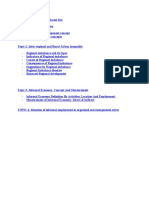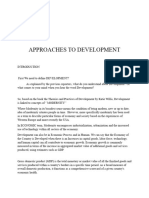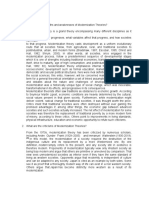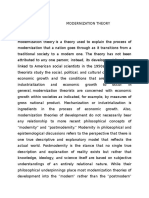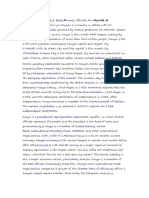0 ratings0% found this document useful (0 votes)
Ambilikile
Ambilikile
Uploaded by
Gysela SylvandThis document discusses different perspectives on the concept of development and theories of development. It addresses the following key points:
1. Development is a multidimensional concept that can be viewed from economic, political, and social perspectives. It involves improvements in areas like economic growth, democracy, education, health, and standards of living.
2. Theories of development discussed include Rostow's stages of growth theory, dependency theory, world systems theory, and Marxist theories of stages of development.
3. Ragnar Nurkse's theory of the vicious cycle of poverty is described, which posits that low income leads to low savings and investment, perpetuating poverty. The strengths and limitations of this theory
Copyright:
© All Rights Reserved
Available Formats
Download as PDF, TXT or read online from Scribd
Download as pdf or txt
Ambilikile
Ambilikile
Uploaded by
Gysela Sylvand0 ratings0% found this document useful (0 votes)
This document discusses different perspectives on the concept of development and theories of development. It addresses the following key points:
1. Development is a multidimensional concept that can be viewed from economic, political, and social perspectives. It involves improvements in areas like economic growth, democracy, education, health, and standards of living.
2. Theories of development discussed include Rostow's stages of growth theory, dependency theory, world systems theory, and Marxist theories of stages of development.
3. Ragnar Nurkse's theory of the vicious cycle of poverty is described, which posits that low income leads to low savings and investment, perpetuating poverty. The strengths and limitations of this theory
Original Description:
Ambiii
Copyright
© © All Rights Reserved
Available Formats
PDF, TXT or read online from Scribd
Share this document
Did you find this document useful?
Is this content inappropriate?
This document discusses different perspectives on the concept of development and theories of development. It addresses the following key points:
1. Development is a multidimensional concept that can be viewed from economic, political, and social perspectives. It involves improvements in areas like economic growth, democracy, education, health, and standards of living.
2. Theories of development discussed include Rostow's stages of growth theory, dependency theory, world systems theory, and Marxist theories of stages of development.
3. Ragnar Nurkse's theory of the vicious cycle of poverty is described, which posits that low income leads to low savings and investment, perpetuating poverty. The strengths and limitations of this theory
Copyright:
© All Rights Reserved
Available Formats
Download as PDF, TXT or read online from Scribd
Download as pdf or txt
0 ratings0% found this document useful (0 votes)
Ambilikile
Ambilikile
Uploaded by
Gysela SylvandThis document discusses different perspectives on the concept of development and theories of development. It addresses the following key points:
1. Development is a multidimensional concept that can be viewed from economic, political, and social perspectives. It involves improvements in areas like economic growth, democracy, education, health, and standards of living.
2. Theories of development discussed include Rostow's stages of growth theory, dependency theory, world systems theory, and Marxist theories of stages of development.
3. Ragnar Nurkse's theory of the vicious cycle of poverty is described, which posits that low income leads to low savings and investment, perpetuating poverty. The strengths and limitations of this theory
Copyright:
© All Rights Reserved
Available Formats
Download as PDF, TXT or read online from Scribd
Download as pdf or txt
You are on page 1/ 10
1. “Development is a concept with many dimensions” Discuss this contention.
Development is a change from a low stage to an advanced stage in all aspect of
life, within a nation is associated with increasing creativity, skills, involvement of people
in decision making for the development of a nation and so more is associated with
achievement of high industrial level. Several philosophers have defined development,
these include Walter Rodney, Karl Marx, Nyerere, Seers and many other. According to
Nyerere “Development is a state of freedom from poverty, ignorance and diseases while
others like Walter Rodney defined development at individual aspect as improvement in
wellbeing, self confidence, capacity and self discipline and at society level as
transformation into a moral, economically, socially and politically active community.
Seers (1972) defined development as creation of condition for realization of human
personality, and value, reduction of poverty and social inequalities and improvement in
employment opportunity creation. Thus development has far being defined differently by
different scholars, philosophers and politicians based on different aspects this makes
development a multi-dimensional concept, embracing all perspectives: political, social
and economic perspectives as follows;
There are three perspectives which are considered when we attempt to define
development. These are:
Economic perspective (economists): Look at indicators of development such as
economic growth of a particular nation like increasing of gross national product (GDP).
Increasing of foreign investments into activities such mining, industries, infrastructure,
banking etc. High level of technology in a country. Increasing income among the
households
Political perspective: Availability of democracy, free and fair election, freedom
of movement, speech, assembling, worship, choosing leaders, opinions etc. Availability
of human rights e.g. right to work, marry, to education, right to an adequate standard of
living like having appropriate food, shelter, water medical care. Low level of corruption
in a country.
Social perspective: Availability of social services e.g. electricity, houses, food,
education health, infrastructure etc. Increasing of life expectancy e.g. in developed
countries most people die within the range of 80 years and above years, but developing
countries you have most of the people dying at ages below 45 years. Lack of diseases
and low mortality rate e.g. for infants, low rates of maternal mortality rates etc
The theorists and different scholars have tried to group development into two
broad streams which explain development in political economy perspective as classical
political economy and modern political economy explained as follows:
Modern political economy theories; These theories explain development as a
modernity concept such that a social transformation process of poor traditional societies
through internal and external efforts into a modern society will answer the progressive
processs as development. These theories are mainly divided into two main theories as
follows:
The Vicious cycle of poverty theory: The theory was propounded by Prof.
Nurkes in which he said that “If a society is poor that society will continue to be poor and
poor forever” thus, it is poor because it is poor. He tries to explain that for that society to
develop it must break free from the circle of poverty hence conclusion can be drawn that
according to Nurkse, development is a progressive freedom from poverty drive. Nurkse
suggested that big push from external forces should be exerted on the poor countries
inform of development projects such that push should be from e.g. financial institutions
and other social assistances.
Prof. Rostow’s five stages of human development; Prof.Rostow views
development as a process that follows a linear trajectory starting from low to high by
passing through five stages of development. He continues by saying that each stage of
human development should be fulfilled clearly in order to allow the society to undergo
the next stage of human development. Therefore, according to Rostow development is a
phased, stage-by-stage linear social development process and that all societies have to go
through the same path from traditional society, transitional phrase, take-off, drive to
maturity to age of high mass consumption.
Consistently the development concept has been explained in classical political view
under political economy perspective using different theories as follows;
Classical political theories: The theories consider liberation from structural
conflicts and class struggles and adherence to the role of the state are the important
indicators of a developing social community. The theories under the above perspective
are explained as follows;
Karl Marx theory of social development: Karl Marx argued that class conflicts
and class struggles between two antagonistic classes; the class of have not (proletariats)
and the rich class (bourgeoisie) are the basic means for positive change in the socialist
economy called social development of which makes a society a transformation through
five stages of human development which are; Primitive accumulation, Feudalism,
Capitalism, Socialism and finally Communalism ( highest stage of social development).
Therefore, development can as well mean a human transformed improvement in social
welfare basically existence and proper adherence of rights to work and happy life define
social development.
Dependency theories; The theories were developed by neo-marxists in between
1950s and 1960s. The school assumes that development in the society can be understood
in connection with the world political economic system, thus development is a victory
against dependency. According to dependency theory, the cause of underdevelopment is
the dependence on industrialized countries while internal factors of developing countries
are considered irrelevant or seen as symptoms and consequences of dependency. Walter
Rodney once argued that, “the intervention of European powers in African social,
economic and political processes throughout the 19th C created a situation of dependency
and led to the impoverishment of African people”. Therefore development is viewed as a
fight against dependency and its vested economic and social exploitation.
World System; The theory was developed by Emmanuel Wallenstein in which he
divided the world into three systems: the core, semi-periphery and periphery where by
core countries are industrialized and highly integrated economies, semi-peripheral
countries are less industrialized than core countries while peripheral countries are poor
countries. A transition from a peripheral country to core country must pass through
semi-peripheral countries. Therefore, development is attained when a country progresses
slowly into semi-periphery or core from a periphery stage.
Nationalist theories of development; The theories explain that development can
be attained when the society become self reliant. They seek to draw development insights
from real African traditions and values in order to transform economically, politically and
culturally. Therefore, theorist under this perspective argue that development is a self
motivation, evocation and enforcements without being dependent on other parties thus
development is a build up character of self reliance and socialism.
Non-liberal theories of social development; The theorists under this perspective
reveal that a command economy is a passive factor for development and suggest that the
wide spread of a free market economy, transfer of technology and private business
enterprising are the active development strategy, therefore according to these theorists
development is a product of more private ownership that brings about competition in a
common society thus development is attained.
In conclusion, although development is multidimensional all the above
perspectives that give the scope of development have a common implication which is a
process towards social, political, economic and cultural welfare improvement to an
individual and a community as a whole, although some of the definitions have a negative
implication in course of bringing development measure should be taken in hand to
combat the rising challenges as all ways are applicable but not all are appropriate in
bringing development.
2. Describe the assumptions of Ragnar Nurke’s theory of vicious circle of poverty
and discuss the strengths and limitations of the theory.
Theory is a statement established by reasonable arguments based on
experimentations, observations that lead to obtaining known facts intended to establish a
particular event. It explains relationships between variables, Ragnar Nurkse (1909-1959)
was an economist who examined tried to examine problem of capital formation in
underdeveloped countries. He developed a theory called the vicious cycle of poverty
which states that “If a country is poor it will remain poor and poor forever” thus a
country is poor because it is poor. Nurkse postulated some arguments based on the
demand and supply sides leading to poverty of which are considered his assumptions as
follows:
Supply side of vicious circle; Prof. Nurkse argued that the reason of poverty in
backward countries ids that in supply side there is small capacity to save resulting from
low level of national income. The low real income is a reflection of low productivity,
which in turn is due largely to the lack of capital. The lack of capital is a result of the
small capacity to save and so the cycle is complete .That is low income-low saving-low
investment-low income.
Demand side of vicious circle; According to Prof. Nurkse, “On the demand side,
the inducement of invest may be low because of the small purchasing power of the
people, which is due to the small real income, which is again due to low productivity.
The level of productivity however, is the result of small amount of capital used in
production which in turn may be caused or at least partly caused by small inducement to
invest. That is Low income-Low Demand-Low investment-Low Productivity-Low
Income.
Nurkse assumes that development is a breakage from poverty cycle that
needs dependent efforts which he named ‘a big push’ from external forces such as
international financial assistance from world bank and International Monetary
Fund(I.M.F).
The following are the strengths of the Ragnar Nurkse vicious circle of poverty;
The theory expresses the circular relationship between demand and supply
side that relevantly affects most of backward countries. For instance, the importation
of consumer goods by most of these countries is because of the low productivity in their
domestic countries, thus leading to less being supplied in the domestic market as the
prices of import rises beyond the purchasing power it becomes difficult to sustain their
living as they cannot afford to pay the price hence poverty circle
Ragnar Nurkse has put much emphasis on the domestic saving, foreign,
foreign aid and important role of the state for a balanced growth; This is relevant
because most of backward countries have low saving behavior thus leading to low
inducement to investments in these countries, also some aids provided from abroad have
assisted development of some schemes. For instance, construction of most road transport
infrastructure in Tanzania is from assistance by the Chinese government.
It is true that for countries to develop they should engage in trade and
enlarge their market by investing in diversified industries in order to break out free
from the poverty circle.
Despite the strengths of Nurkse theory of vicious circle of poverty critics have been
offered against the theory due to weaknesses of the theory. The following are the
weaknesses of the theory:
Nurse’s theory fails to tell us the root causes of underdevelopment of Third
World countries; rather it tells us the outcomes of underdevelopment which could be a
result of external forces for example the rise of capitalism in Europe.
He fails to show how did European countries managed to break the circle of
poverty if formerly all countries lived in the same circle of poverty.
Unclear way of breaking the circle; Theory does not state how the backward
countries can break free from the circle it shows the situation present in the countries.
In conclusion, the Nurkse theory of vicious circle of poverty has more positive
implications if taken into consideration by the backward countries because it alarms the
states to wake up from impoverishment of everything, despite some of its weaknesses
such as unclear breakthrough from poverty measure suggestion, therefore to combat
poverty state and public role should play major part in bringing development.
3.“Without unity, there is no future for Africa.” Julius Nyerere, 1997. Discuss the
above contention in the context of Pan-Africanist movement
Pan-Africanism, originates from two words Pan which means all and Africans,
which means people of Africa. As a movement Pan-Africanism is a unification tool that
seeks to unite Africans as a part of global African community, these include Africans in
Africa and those in diaspora. It should be noted that Pan-Africanism is a product of the
European slave trade, thus it was a movement that sort to bring reputation by removing
elements of humiliation and slavery.
“Without unity there is no future for Africa”, said by Tanzania’s first president, Julius
Nyerere one of the founding fathers of OAU( Organization of African Unity) during his
speech in Ghana, Accra on the occasion of Ghana’s 40th independence anniversary on 6th
March 1997. In the question of continental Unity, Nyerere was in the second gap arguing
that in order to have African unity the first step is to form Regional integrations since
immediate African unity after political independence with economic dependence was not
easy due to poverty, economic backwardness, regionalism and ethnicity. It is true that
without unity there is no future for Africa as argued by Nyerere in 1997 relating to Pan-
Africanist movement with its objectives as follows;
Securing civil and political right for African people, Pan African movement
aimed to regain both civil and political rights for the African people in Africa and
diaspora, since they were disregarded and humiliated, this made Nyerere to advocate for
African unity since unity would not make us rich but it would make it difficult for Africa
and the African people to be disregarded and humiliated and will increase effectiveness
of the decision we make and try to implement for our development.
Promoting friendly relation between races, soon after the attainment of
independence in African countries, our former colonial masters were dividing African
people into Anglophones, Francophone and Lusophones, thus Nyerere argued that the
roles of Africans according to the language of their former colonial masters must be
rejected, thus Africans should unite cause natural owners of those wonderful languages
are busy building a united Europe though Europe is stronger even without unity, so by
unity among African countries and Africa would be the strongest continent in the world.
This explains why without unity there is no future for Africa.
To fight colonialism and neo-colonialism in Africa, should be born in mind that
neo-colonialism operates through financial institutions IMF and WB due to economic
dependence of African countries to their former colonialists, thus in order to remove evils
of neo-colonialism, Nyerere advocated for the unity of Africans through regional
integrations so that we can help each other and reduce dependence on Europe. The reality
is that our continent is the poor and weak among most countries and unity will not solve
the case of weakness but unification will begin to fight weakness in us thus without it no
future for Africa.
Improving conditions of Black people in Africa, America and elsewhere in
the world, Since African continent is the most poorest continent in the world and has
always remain in the same trend due to wave of neo-colonialism, thus using principle of
Pan-Africanism, basically unity as a means of rejuvenating the conditions of the blacks in
the world, Pan-Africanization of capital thus sharing of resources among the African
countries will reduce such dependence and would build a strong Blacks society that is
heading toward development in turn a promising future . For instance, efficiency of
opened regional development banks such as Southern Africa Development bank, Eastern
Africa Development bank which would advance loans amongst African member states
hence financial dependence. Expropriation alone as a legal or political act does not settle
matters by a long chalk between exploiters and exploited (V.Lenin, Why the rich must be
expropriated)
Unity as a historical source of development; Tracing back from the times when
Ghana was in national liberation struggles for its independence, Kwame Nkrumah one of
the fore-founders of Organization for Africa Unity advocated that gaining of Ghana
independence is nothing until collaboration and cooperation hands from all nationalists to
bring African continent free from colonialism, this shows that since unity was a pre-
historic factor for gaining of independence of other African countries at the end it
emphasizes that going on unification will lead Africa to more progress unless otherwise
no future for Africa as Nyerere’s speech commented.
Despite the above points that sustains future for African continent in other means
development of Africa is through unification, the main challenge is faced which is the on-
going gaps and inequalities among small groups in an African country specifically that is
Africa will not develop continental wise if it fails to unify small groups in their countries
individually, for instance; religionalism in religion institutions, political classes and
ignorant mindset of collaborations. Therefore, to have not only a future but a promising
one, unification of regions at country level and unification at continent level should be
taken into consideration.
4.With relevant examples from any African country of your choice. Discuss five
principles of good governance and their implications.
Governance is a process of decision making and through which the decision made
are either less or not implemented at all depending on the on-going events in the political
environment. Government has lots of actors such as the government, Non-governmental
Organizations, military, religious leaders and institutes at national level in addition to that
actors include international donors and multi-national corporations which play important
role in decision making or in one way or another influence decision making process. All
actors other than the government are term as “Civil society”. Governance can be termed
as good or bad depending on how ii manages the affairs and fairs of the organization in
concern hence affecting development. Good governance is the one that implements the
democratic principles towards development while contrary to it is bad governance. Using
Tanzania as an example, the following are the principles of good governance that lead to
development;
Citizen participation, good governance considers participation by both men and
women either direct participation or representative participation, direct participation takes
place where population is small for instance in rural areas of Tanzania at village
government level and indirect participation as the MPs visit their constituencies and
forward the aired views and problem of resident and represents them to the government
through the parliament, this helps the government in power to address the demands of its
citizen such as ensuring power supply and water in some of the rural areas of Tanzania
hence allowing undertaking of different economic activities such as trade and agriculture
leading to development of our economy.
Rule of law; Rule of law states that no one is above the law that is the law
exercises its authority above all beings in a state. Good governance guarantees adherence
of the rule of law by ensuring that the laws stipulated by the established constitution are
followed by leaders and the citizens in the country, this welcomes the role of the judicial
system to arrest any crime in order to serve justice and fairness as the elements to
ensuring peace, security and order to promote concentration in productive activities that
brings about development. For instance in Tanzania the criminals are arrested, the
unprivileged are given their deprived rights as bill of right is the arm for the government
in power and the leaders are assessed in manner of their performance to check corruption
at government and national level at large.
Accountability and transparency; Good governance incorporates elements of
accountability and good governance as the government fulfils the task addressed to it at a
given length of time and lets the community around be aware of the on-going political
waves and governmental decisions and activity, this allows the public to scrutinize the
activity of the government in power in order to work efficiently toward attaining
development. For instance, in the fifth reign of President John Pombe Magufuli the
leaders under the ruling government have been showing improvements in performance of
the addressed duties and delivering of reliable information to the public concerning
different matter this one of steps towards development.
Consensus orientation; Consensus orientation is simply the mediation strategy
that the governing body should possess in order to solve and resolve conflicts among the
ruled, thus the citizens. Good governance has high mediation and diplomatic means of
solving conflicts without civil war or group separation outbreaks occurring in the
concerned country. For instance, in Tanzania the governance has resolved and is still
resolving the conflicts between the pastoralist families and crop farmers’ families in
Kilosa region on land pressure by properly allocating demarcation on the extent of
activities of both groups, this has brought peaceful situations amongst though not at total
extinct of conflicts. In the way of bringing development good relationship among the
citizens is required thus by consensus in practice collaborative hands toward development
are engaged.
Equity; Good governance guarantees fairness and equal judgments between the
ruled. The governing body ensure that there is no subjugation, discrimination or
segregation in the society, all people are equally addressed their needs. For instance, in
the provision of social services the government of Tanzania provides mutually to most
areas and power rationing cases are minimized although there are some areas cannot
access some social services such as electricity and water but the government is trying
hard to ensure that service are mutually provided between urban, rural and suburbs.
Despite the long talks about good governance and its implication to bring
development, good governance can be summed up to basically mean not ruling but
serving others, servitude is a true description of a good leader, therefore the governments
all over the world should look upon how they are going to serve their citizens and not on
being bosses and ruling instead of leading.
.
You might also like
- Multiple Questions and Answers Prepared by Malesela Leso PDFNo ratings yetMultiple Questions and Answers Prepared by Malesela Leso PDF29 pages
- Research Aim Scope of Research Research Methodology Research QuestionsNo ratings yetResearch Aim Scope of Research Research Methodology Research Questions13 pages
- International Journal of Humanities and Social Science Invention (IJHSSI)No ratings yetInternational Journal of Humanities and Social Science Invention (IJHSSI)12 pages
- Theories of Social Development (Soci 403) .: STUDENT I.D: 10250331No ratings yetTheories of Social Development (Soci 403) .: STUDENT I.D: 102503317 pages
- Neo Evolutionary, Modernisation, Neo ModernisationNo ratings yetNeo Evolutionary, Modernisation, Neo Modernisation30 pages
- Theories and concepts of Development 2-1No ratings yetTheories and concepts of Development 2-119 pages
- Introduction To Development Studies 231109 185906No ratings yetIntroduction To Development Studies 231109 185906103 pages
- Introduction To Development Studies PDFNo ratings yetIntroduction To Development Studies PDF102 pages
- A Comparative Analysis of Global North and Global South Economies (Odeh)No ratings yetA Comparative Analysis of Global North and Global South Economies (Odeh)11 pages
- Robinson, William I.: Orfalea Center For Global and International Studies UC Santa BarbaraNo ratings yetRobinson, William I.: Orfalea Center For Global and International Studies UC Santa Barbara19 pages
- What Are The Strengths and Weaknesses of Modernization Theories100% (3)What Are The Strengths and Weaknesses of Modernization Theories3 pages
- Development Studies and The Development Impasse50% (2)Development Studies and The Development Impasse7 pages
- Conceptual Understanding of Development-Human, Social, EcologicalNo ratings yetConceptual Understanding of Development-Human, Social, Ecological24 pages
- Long Essay Assignment Hannah Krienke (1584838)No ratings yetLong Essay Assignment Hannah Krienke (1584838)10 pages
- Introduction To Project Planning, Appraisal and FiananceNo ratings yetIntroduction To Project Planning, Appraisal and Fianance119 pages
- Modernization Theories of Development AnNo ratings yetModernization Theories of Development An6 pages
- College of Business and Economics DEPARTMENT OF EC Part 1No ratings yetCollege of Business and Economics DEPARTMENT OF EC Part 18 pages
- Independence-Movement - S-Africa-Kenya-Nigeria-2 3 2No ratings yetIndependence-Movement - S-Africa-Kenya-Nigeria-2 3 22 pages
- FCL Income Tier Listing Website Oct. 2021 1No ratings yetFCL Income Tier Listing Website Oct. 2021 14 pages
- Africa Studies Bulletin No71 Winter 0910No ratings yetAfrica Studies Bulletin No71 Winter 091091 pages
- Complete Download Ecology and power in the age of empire : Europe and the transformation of the tropical world First Edition Ross PDF All Chapters100% (2)Complete Download Ecology and power in the age of empire : Europe and the transformation of the tropical world First Edition Ross PDF All Chapters65 pages
- Bantu People Four Major Divisions of The BantuNo ratings yetBantu People Four Major Divisions of The Bantu2 pages
- Latest Developments in Steelmaking Capacity 2023No ratings yetLatest Developments in Steelmaking Capacity 202358 pages
- Jafer Books Online Store Book List Ethiopia A30% (1)Jafer Books Online Store Book List Ethiopia A341 pages
- Dates of Independence of African NationsNo ratings yetDates of Independence of African Nations8 pages
- Community Psychology in South Africa Ori20160208-28293-O2wd07No ratings yetCommunity Psychology in South Africa Ori20160208-28293-O2wd0718 pages
- Geopolitical Dynamics in The Horn of Africa and Mechanisms For CollaborationNo ratings yetGeopolitical Dynamics in The Horn of Africa and Mechanisms For Collaboration6 pages
- Complete Download eTextbook 978-1285436968 The Earth and Its Peoples: A Global History, Volume II: Since 1500: 2 PDF All Chapters100% (4)Complete Download eTextbook 978-1285436968 The Earth and Its Peoples: A Global History, Volume II: Since 1500: 2 PDF All Chapters65 pages
- Which of The Following Was The Major Effect of The Neolithic Revolution?No ratings yetWhich of The Following Was The Major Effect of The Neolithic Revolution?21 pages
- CH 1.3-Trade Networks of Asia and AfricaNo ratings yetCH 1.3-Trade Networks of Asia and Africa6 pages
- The Single Story of Africa: Yesha Bhojak Grade 9A Language and Literature Image of Africa, Persuasive EssayNo ratings yetThe Single Story of Africa: Yesha Bhojak Grade 9A Language and Literature Image of Africa, Persuasive Essay5 pages
- The Zimbabwe Industrial Revolution Plan: For The Church Created by Hannington MubaiwaNo ratings yetThe Zimbabwe Industrial Revolution Plan: For The Church Created by Hannington Mubaiwa20 pages
- DOING BUSINESS Historical-Data - COMPLETE-dataset-with-scoresNo ratings yetDOING BUSINESS Historical-Data - COMPLETE-dataset-with-scores1,214 pages
- Multiple Questions and Answers Prepared by Malesela Leso PDFMultiple Questions and Answers Prepared by Malesela Leso PDF
- Research Aim Scope of Research Research Methodology Research QuestionsResearch Aim Scope of Research Research Methodology Research Questions
- International Journal of Humanities and Social Science Invention (IJHSSI)International Journal of Humanities and Social Science Invention (IJHSSI)
- Theories of Social Development (Soci 403) .: STUDENT I.D: 10250331Theories of Social Development (Soci 403) .: STUDENT I.D: 10250331
- Neo Evolutionary, Modernisation, Neo ModernisationNeo Evolutionary, Modernisation, Neo Modernisation
- A Comparative Analysis of Global North and Global South Economies (Odeh)A Comparative Analysis of Global North and Global South Economies (Odeh)
- Robinson, William I.: Orfalea Center For Global and International Studies UC Santa BarbaraRobinson, William I.: Orfalea Center For Global and International Studies UC Santa Barbara
- What Are The Strengths and Weaknesses of Modernization TheoriesWhat Are The Strengths and Weaknesses of Modernization Theories
- Conceptual Understanding of Development-Human, Social, EcologicalConceptual Understanding of Development-Human, Social, Ecological
- Introduction To Project Planning, Appraisal and FiananceIntroduction To Project Planning, Appraisal and Fianance
- College of Business and Economics DEPARTMENT OF EC Part 1College of Business and Economics DEPARTMENT OF EC Part 1
- Independence-Movement - S-Africa-Kenya-Nigeria-2 3 2Independence-Movement - S-Africa-Kenya-Nigeria-2 3 2
- Complete Download Ecology and power in the age of empire : Europe and the transformation of the tropical world First Edition Ross PDF All ChaptersComplete Download Ecology and power in the age of empire : Europe and the transformation of the tropical world First Edition Ross PDF All Chapters
- Community Psychology in South Africa Ori20160208-28293-O2wd07Community Psychology in South Africa Ori20160208-28293-O2wd07
- Geopolitical Dynamics in The Horn of Africa and Mechanisms For CollaborationGeopolitical Dynamics in The Horn of Africa and Mechanisms For Collaboration
- Complete Download eTextbook 978-1285436968 The Earth and Its Peoples: A Global History, Volume II: Since 1500: 2 PDF All ChaptersComplete Download eTextbook 978-1285436968 The Earth and Its Peoples: A Global History, Volume II: Since 1500: 2 PDF All Chapters
- Which of The Following Was The Major Effect of The Neolithic Revolution?Which of The Following Was The Major Effect of The Neolithic Revolution?
- The Single Story of Africa: Yesha Bhojak Grade 9A Language and Literature Image of Africa, Persuasive EssayThe Single Story of Africa: Yesha Bhojak Grade 9A Language and Literature Image of Africa, Persuasive Essay
- The Zimbabwe Industrial Revolution Plan: For The Church Created by Hannington MubaiwaThe Zimbabwe Industrial Revolution Plan: For The Church Created by Hannington Mubaiwa
- DOING BUSINESS Historical-Data - COMPLETE-dataset-with-scoresDOING BUSINESS Historical-Data - COMPLETE-dataset-with-scores


